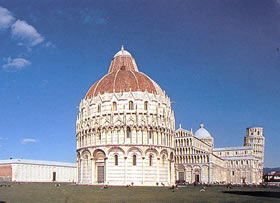Pisa - The leaning tower of Pisa

The Leaning Tower of Pisa not only is the bell-tower of the Dome but it is also, and above all, the most characteristic construction of the city. Its popularity is mainly due to its peculiar inclination that made it famous worldwide and that has caused a range of restoration works, for it was closed for more than ten years.
The Dome's bell tower is a particular building not only for its rake.
In effect, also its out-of-the-way siting in comparison to the Dome is quite unusual. To the detriment of its function "subordinated" to the cathedral, its unknown architect (Bonanno and Gherardo di Gherardo are the most credited) had probably conceived it as a point of reference of the then Piazza dei Miracoli complex, which could be visible from any part of the city thanks to the tower. This explains its remarkable mass and its distance from the Dome.
The construction of the Tower started in 1174 according to the Pisan calendar that started about ten months earlier. Therefore, it is thought that the creation of the building dates to 1173. It was interrupted several times, probably because of the sinking of the soil that has always prevented it from standing upright.
Nevertheless, at that time, such a phenomenon happened more often that it can be imagined. The insufficient information available has not helped scholars to complete the frame of the operations that took place in two-hundred years. Yet, it has already been ascertained that the original idea of the bell-tower did not foresee the incredible inclination that increased its fame.
A second phase of the works, which Giovanni Pisano also participated to, started in 1275 with the construction of three more storeys. The belfry was added around the first half of the XIV century. In the XIX century, some works that brought to light part of its foundations underground, were carried out.
It was a big mistake, though, because they altered the stability of the tower and accelerated its process of inclination. From 1990 to 2001, therefore, the Tower was closed to visitors for a difficult and elaborated recovery work that eventually allowed it to be visited again. Today, it is possible to go inside even if the entrance is very limited. The tower has a circular layout and decorations that recall the apse of the Dome.
Once, above the entrance door, there was a Madonna col Bambino, a work attributed to Andrea Guardi. At the sides of the entrance, there are two pictorial bars and a bas-relief representing some ships and a beacon that was a copy of a more ancient one located near the entrance to S. Ranieri.
The storeys are characterized by a repetition of galleries and arcades, with the exception of the bell-tower where seven bells are set. 294 steps must be climbed to arrive to the terrace of the belfry.
History of Tower of Pisa
The Tower of Pisa is one of the most fascinating and worldwide-known Italian monuments, admired for the exceptional elegance of its architectural structure, as well as for the extraordinary inclination.
Founded in 1173 as steeple annexed to the Dome (started in 1064 by the architect Buscheto) and to the Baptistery (started in 1152 by the architect Deotisalvi) in "Piazza dei Miracoli" (Miracles Square), the "leaning tower" is commonly attributed to Bonanno.
During some excavations carried out in the 19th century in the foundations of the steeple an urn was found having this name, which was thought to refer to the tower's builder. Scholars proposed to identify the Bonanno mentioned on the urn with the famous sculptor from Pisa who made the bronze gates of Pisa's Dome (where the gate of the facade, of 1179, went lost, while the other one, the so-called "Gate of S. Ranieri", is still preserved and can be seen outside the southern transept) and the gate of Monreale's Cathedral (dated 1185).
However, after only 12 years (1185) there were the first signs of subsidence of the ground, which caused the tower's inclination and led to the interruption of works in the middle of the third floor.
The construction was restarted only in 1275 by Giovanni di Simone and finished in the second half of the 14th century. Together with the Baptistery, the steeple tower is one of the first monuments in which the great novelty of the architectural language used in the neighbouring Dome is assimilated and proposed after some years.
With its circular plan, it shows again the theme of small loggias with arches on columns, which will become one of the most successful themes in the Romanic period in Pisa. In the first order at the foot there is the theme of blank arches on semi-columns framing lozenges, that is taken from the Dome.
On the top it ends with the cylindrical steeple cell with a lower diameter than the central part of the tower. Above the entrance door there was a sculpture of the Madonna with Child, ascribed to Andrea Guardi and now preserved at the Dome's Opera Museum. In the last years the Tower of Pisa has undergone some balancing interventions that have allowed to reduce its inclination: the subsidence of the ground also involves other monuments in Pisa, as for example the steeples of the churches of St. Michele degli Scalzi and St. Nicola.